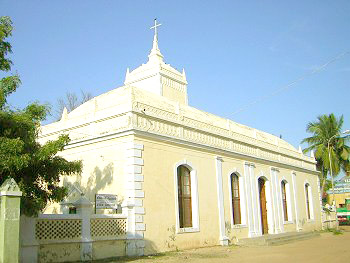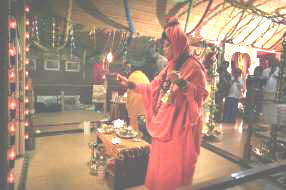|
Denmark: Welcoming Many
© Urmila Goel, www.urmila.de 2002 [also
in
PDF]

Church of Zion in
Tranquebar, in Nagapattinam District in Tamil
Nadu dates back to 1701 and was founded by
the Danes. It is the oldest Protestant church
in India. |
1713 the Tamil boy Timotheus is presented at the
court in Copenhagen. He is brought from the Danish
colony Tranquebar by missionaries of
the "Dänisch-Hallesche Mission", the first
protestant mission in Southern India from 1706 to
1837. At their school he was taught not only the
Christian religion but also the Danish language.
Now he is brought to Europe as a show piece.
Seeing Timotheus the widow of the king is so
much impressed, that she asks for a Christian Tamil
boy for herself, whom she gets. Timotheus gets to
know the Tamils already living in Copenhagen. When
his relationship to a Tamil girl - a former slave
of a Danish priest in Tranquebar - becomes public
in 1714, prejudices about the sexual permissiveness
of Tamils are strengthened.
Nonetheless Timotheus begins his studies to
become a missionary. These are interrupted when the
king allows a journey to Halle. After his return
Timotheus is selected to teach two Danish
candidates for the mission in Portuguese and Tamil.
Soon, however, another training is sought for
Timotheus, he begins an apprenticeship as a
bookbinder, which he completes in 1717. After
marrying the Tamil Sahra he returns to India, where
he works for the mission. (Liebau 1996, 9-18)
Today - long after Denmark has ceased to be a
colonial power - the link to Tranquebar seems to
have gone as well. Only few immigrants of Indian
origin live in the country, the considerable number
of Tamils are refugees from Sri Lanka, the largest
South Asian group in Denmark are the Pakistanis.
The latter seem to have come as guest workers in
the 1960s and 70s (Steen 1993, 103). Ali (1982,
84-85) gives an account of the Pakistanis in
Denmark at the beginning of the 1980s.
According to this report they come mainly from
the Punjab, the majority are men, who work in the
production and service sectors of the economy. An
Imam of a mosque is a Pakistani, there are some
Urdu magazines and already 1982 a convention of
Pakistanis in Denmark has been hold. A few years
later in 1985 the Vishwa Hindu Parishad in Denmark
invites to an international Hindu Conference in
Copenhagen with the objective of bringing the
European Hindu community together.
While the majority of immigrants of Indian or
Pakistani origin have in 1998 the Danish
nationality, most Tamils who came later as refugees
are legally still Sri Lankans. Their entry is the
second influx of refugees after the 4000 to 5000
Asians coming from East Africa at the beginning of
the 1970s . In fact Denmark, which has had a
history of assisting refugees (Steen 1993, 87) ,
received an unusual large number of Tamils for its
size (81).
When the first Tamils applied for asylum in Denmark
in 1984 they could not refer to an ethnic support
group living there already, they came to a
culturally totally alien country (81). The support
came from the Danish state. Although in 1986
Denmark tightened its Aliens Act (87), most Tamils
have been recognised as de facto refugees, which
gives them a legally secure status, allows for
family reunion (81) and provides them access to the
same social services as the Danes (106).
The refugees pass through a process beginning
with the pre-asylum phase from a few months to
several years in refugee camps, where they are not
entitled to work and their children cannot attend
the Danish schooling system, continuing with the
integration phase, when their asylum has been
granted and they are - for in average17 months - in
the care of the Danish Refugee Council, and finally
finding their welfare in the responsibility of the
municipality. (94-95)
Confronted with the bad reputation of other
refugees and the guestworkers of the 60s and 70s
the Tamils make attempts to differentiate
themselves from these (103). Their polite and
reserved behaviour makes them the ideal refugee for
the Danes, makes them the favoured group of the
officials (102-103). Nonetheless their life is not
easy. Besides being faced by patronising and
missionising instincts by the Danes, who are guided
by cultural stereotypes and use their assymetrical
power position (100), they increasingly have
problems finding employment (97). The Danish system
makes them clients rather then acting subjects
(106).
After the first pioneers had found their way to
Denmark chain migration set in. Newcomers - mainly
young bachelors - are related to earlier refugees,
are their friends or school-mates from the home
village. Virtually nobody leaves Sri Lanka for
Denmark without contacts and telephone numbers of
Tamils living there already. Once arrived they
often become closely attached to their "contact"-
families. (166) The social life takes place
primarily in the Tamil community. Only few have
relationships with Danish women and even less
legalise these. (176) There is no feeling of
belonging to the place they live in, which hinders
also the establishment of their own institutions
(186).
In 1985 the need for a Hindu temple is first
formulated (183). The wish is however not strong
enough to put it to realisation (185). The
religious rites are performed by a travelling
Brahmin (183). The first Tamil death in Denmark
brings total confusion about the rituals, a book of
verses is sent for in Germany, but there are not
the right persons present to perform the service
(189). Nonetheless Tamils from all over Denmark
attend the burial as they were called by the leader
of the LTTE in Denmark. Thus it became a political
demonstration of the refugees in exile. (190-191)
Well organised Tamil militant groups in fact play
an important role in the life of the Tamil
community in Denmark. Several groups compete with
each other (129). The pressure on the refugees to
support them financially is so high, that many have
complained to the Danish Refugee Council and have
requested its help against this (136).
With the emergence of the internet also the Tamil
community uses this medium. For some time the
English www.tamil.dk gives a forum to Tamil issues.
But not only the Tamils can be found in the virtual
world. There are, for example, some appearances of
second generation Indians. A student with roots in
Punjab refers to these on his homepage and on Dr.
Bombay's homepage one learns about his
Danish-Indian parents.
|
Shakti in Denmark - Marianne
Qvortrup Fibiger (Aarhus University, Denmark) -
Abstract of Paper presented at the 3rd Congress of
the European Association for the Study of Religions
(EASR), 8.-10. May 2003, Bergen (Norway) -
|

Shakti in Denmark
- a focal point for many Tamils in
Diaspora
|
" In Denmark we have two consecrated Hindu
temples: one dedicated to Vinayakar or the
elephant-headed Ganesha and the other to the
goddess Abirami, where an autodidact laywoman,
Lalitha Sripalan works as priest, shakti-medium and
consequently as healer. This makes her well known
among Tamils in Diaspora in general, who consult
her either by phone, mail or by visiting the
temple. This paper will describe the history of
Lalitha Sripalan, showing how the Diaspora
situation has given her options, that she
presumably would not have accomplished had she been
in Sri Lanka. The paper will discuss her local but
also international role among Tamils, and by using
her as an example it will show how the Tamil Hindu
tradition has adapted to the Danish environment. As
a crucial example I will use shakti and its
manifestations through Lalitha Sripalan following
the red-letter days in the Danish calendar to a
certain extent, however taking a cyclical
understanding of time into account."
|